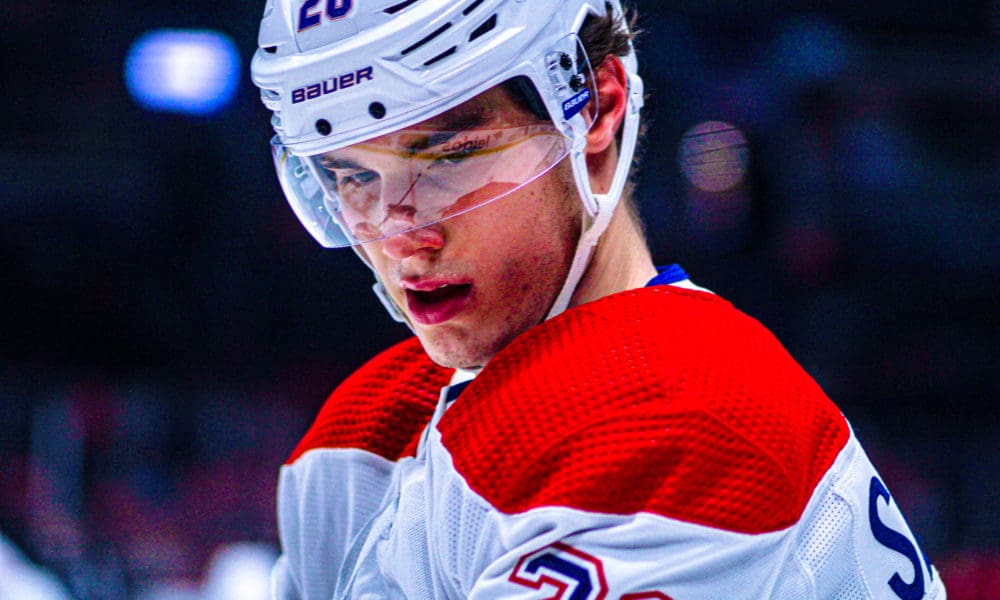Canadiens Analysis
Montreal Canadiens Forward Juraj Slafkovsky’s Usage Next Year

ESPN released its NHL projections for next season, including predictions for the various members of the Montreal Canadiens.
Most of the projections are fairly reasonable. They expect Cole Caufield to increase his scoring and finish the season with 70 points, while Nick Suzuki will once again earn more than 60 points. Beyond those two, no one else on the roster is expected to pass the 40-point mark, except one player.
It’s not Kirby Dach, Rafael Harey-Pinard, or even Josh Anderson.
Rather, ESPN believes Juraj Slafkovsky will score 22 goals and 33 assists to reach 55 points, a significant uptick compared to his rookie season.
According to the projections, Slafkovsky will finish the season with more points than players such as Filip Forsberg, Brad Marchand, Josh Norris, and Brock Nelson.
Canadiens fans will surely applaud the enthusiastic approach by ESPN, but they’re also quite aware that Slafkosvky only scored four goals and six assists in 39 games last year, which gave him a 21-point, 82-game pro-rated season.
An uptick in scoring due to his overall progression is to be expected, however, it won’t account for more than doubling his offensive output.
This pass from Kaiden Guhle to setup Juraj Slafkovsky’s goal was GODLY. #GoHabsGo
pic.twitter.com/IkoDXDJqlv— Nathan "Grav" (@NathanGraviteh) November 6, 2022
The Ice Time Issue
The first thing that will have to occur if Slafkovsky is to increase his scoring is better usage.
He featured on 10 different line combinations in just 39 games, the vast majority of which was spent alongside either Jake Evans, Christian Dvorak, Josh Anderson, or Michael Pezzetta.
And while Anderson certainly represents a decent linemate, we must keep in mind that Anderson only played alongside Slafkosvky without the presence of Pezzetta, Dvorak, or Evans for a little over 30 percent of their total ice time together.
It explains why Slafkovsky was the second-least used player among regulars last year, earning just 10:47 of average ice time per game at 5v5. Both Alex Belzile and Rem Pitlick were given more ice time, which is somewhat surprising since the team did not figure that either player was part of their long-term rebuild. Only Michael Pezzetta was allotted less ice time at 5v5 for the Montreal Canadiens last season.
In total, Slafkovsky played almost 80 percent of his 5v5 ice time alongside either Dvorak or Evans, who both struggled to produce any semblance of offence last season.
To increase his ice time, Slafkovsky will have to be used outside of the bottom six, with a very important caveat.
The reason Slafkovsky’s ice time is so low is that Martin St-Louis did not trust him in high-pressure situations. When the game was on the line, Slafkovsky was glued to the bench or demoted to the fourth line.
It happened almost on a nightly basis.
For example, on November 29, Slafkovsky was given a little over three minutes of ice time at 5v5 with Sean Monahan and Anderson. His final three minutes were played with Evans and Pezzetta.
Simply put, despite sometimes featuring in the “top-nine” from a logistics standpoint, he spent much of those games playing on the fourth line.
Not every example is as egregious, but the demotions still account for a considerable downtick in shifts and quality of teammates.
On December 19, Slafkovsky was given roughly seven shifts of 5v5 ice time with Jonathan Drouin and Kirby Dach but finished the game by playing his final two shifts with Evans and Anthony Richard.
It’s rather difficult to find consistency if you’re almost guaranteed to receive a demotion when the game is on the line.
Slafkovsky has been benched for the 3rd period. Skipping his turn.
— Habs Fan TV (@HabsFanTV_) January 8, 2023
Brass Tacks
Simply put, we can safely say that Slafkovsky will not more than double his output without a little help from his friends, and that includes the head coach.
To be perfectly fair, the Canadiens underwent a ridiculous stretch of injuries last season, which complicated usage. They also had far too many underwhelming, overpaid forwards in the lineup, an issue that has since been rectified, for the most part.
It’s also normal for a coach to ease a player into the league. Slafkovsky was just 18 years old, a veritable babe in the woods who had just endured a summer filled with team events and media engagements due to his status as the first-overall pick at the 2022 NHL Entry Draft.
We should also mention that Slafkovsky was used on the powerplay, albeit rather sparingly.
But even if we keep his powerplay usage in mind, Slafkovsky was one of the least-used high-profile rookies in Montreal Canadiens history.
To drive the point home, Slafkovsky received less ice time during his rookie season than Guillaume Latendresse, Alex Galchenyuk, Josef Balej, David Desharnais, Andrei Kostitsyn, Nikita Scherbak, Jesperi Kotkaniemi, Jesse Ylonen, Jacob de la Rose, Jiri Sekac, Charles Hudon, Sergei Kostitsyn, Chris Higgins, Blake Geoffrion, and Matt D’Agostini did during their first year in the league.
With all due respect to the aforementioned players, the Canadiens are likely hoping that Slafkovsky develops into a player who can make a greater impact throughout the season.
And it all starts with opportunities.
Vincent Lecavalier stated he was given as much ice time as Slafkovsky during his rookie year, which led some to believe that a massive surge in production was possible.
In fact, Lecavalier received more ice time than Slafkovsky in his first year, but only two or three additional shifts per night.
But that’s not as important as what happened the following year when Lecavalier more than doubled his offensive output.
The real secret? Lecvalier was given more than 19 minutes of ice time per game.
No one expects Slafkovsky to reach that mark, but it’s quite clear that an uptick of ice time is in order if the Montreal Canadiens expect Slafkovsky to develop into an elite player.

